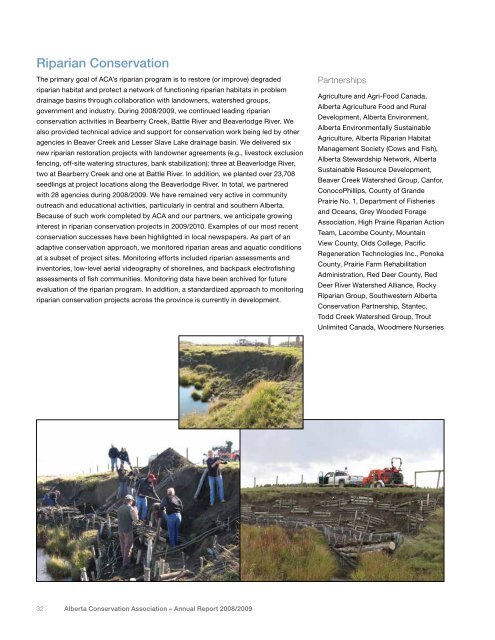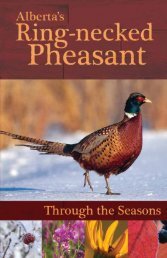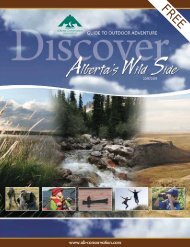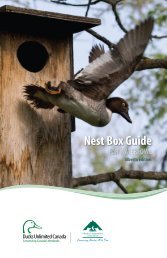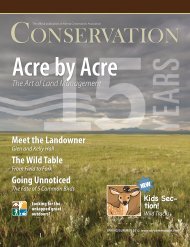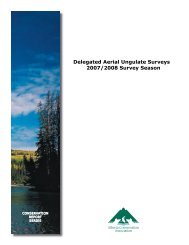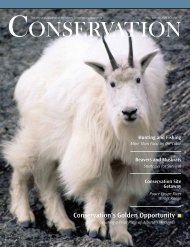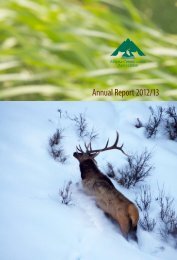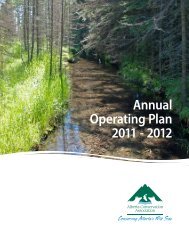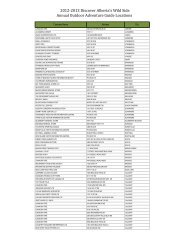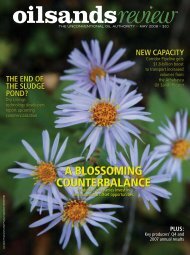Annual Report 2008/2009 - Alberta Conservation Association
Annual Report 2008/2009 - Alberta Conservation Association
Annual Report 2008/2009 - Alberta Conservation Association
Create successful ePaper yourself
Turn your PDF publications into a flip-book with our unique Google optimized e-Paper software.
Riparian <strong>Conservation</strong><br />
The primary goal of ACA’s riparian program is to restore (or improve) degraded<br />
riparian habitat and protect a network of functioning riparian habitats in problem<br />
drainage basins through collaboration with landowners, watershed groups,<br />
government and industry. During <strong>2008</strong>/<strong>2009</strong>, we continued leading riparian<br />
conservation activities in Bearberry Creek, Battle River and Beaverlodge River. We<br />
also provided technical advice and support for conservation work being led by other<br />
agencies in Beaver Creek and Lesser Slave Lake drainage basin. We delivered six<br />
new riparian restoration projects with landowner agreements (e.g., livestock exclusion<br />
fencing, off-site watering structures, bank stabilization); three at Beaverlodge River,<br />
two at Bearberry Creek and one at Battle River. In addition, we planted over 23,708<br />
seedlings at project locations along the Beaverlodge River. In total, we partnered<br />
with 28 agencies during <strong>2008</strong>/<strong>2009</strong>. We have remained very active in community<br />
outreach and educational activities, particularly in central and southern <strong>Alberta</strong>.<br />
Because of such work completed by ACA and our partners, we anticipate growing<br />
interest in riparian conservation projects in <strong>2009</strong>/2010. Examples of our most recent<br />
conservation successes have been highlighted in local newspapers. As part of an<br />
adaptive conservation approach, we monitored riparian areas and aquatic conditions<br />
at a subset of project sites. Monitoring efforts included riparian assessments and<br />
inventories, low-level aerial videography of shorelines, and backpack electrofishing<br />
assessments of fish communities. Monitoring data have been archived for future<br />
evaluation of the riparian program. In addition, a standardized approach to monitoring<br />
riparian conservation projects across the province is currently in development.<br />
Partnerships<br />
Agriculture and Agri-Food Canada,<br />
<strong>Alberta</strong> Agriculture Food and Rural<br />
Development, <strong>Alberta</strong> Environment,<br />
<strong>Alberta</strong> Environmentally Sustainable<br />
Agriculture, <strong>Alberta</strong> Riparian Habitat<br />
Management Society (Cows and Fish),<br />
<strong>Alberta</strong> Stewardship Network, <strong>Alberta</strong><br />
Sustainable Resource Development,<br />
Beaver Creek Watershed Group, Canfor,<br />
ConocoPhillips, County of Grande<br />
Prairie No. 1, Department of Fisheries<br />
and Oceans, Grey Wooded Forage<br />
<strong>Association</strong>, High Prairie Riparian Action<br />
Team, Lacombe County, Mountain<br />
View County, Olds College, Pacific<br />
Regeneration Technologies Inc., Ponoka<br />
County, Prairie Farm Rehabilitation<br />
Administration, Red Deer County, Red<br />
Deer River Watershed Alliance, Rocky<br />
Riparian Group, Southwestern <strong>Alberta</strong><br />
<strong>Conservation</strong> Partnership, Stantec,<br />
Todd Creek Watershed Group, Trout<br />
Unlimited Canada, Woodmere Nurseries<br />
32 <strong>Alberta</strong> <strong>Conservation</strong> <strong>Association</strong> – <strong>Annual</strong> <strong>Report</strong> <strong>2008</strong>/<strong>2009</strong>


